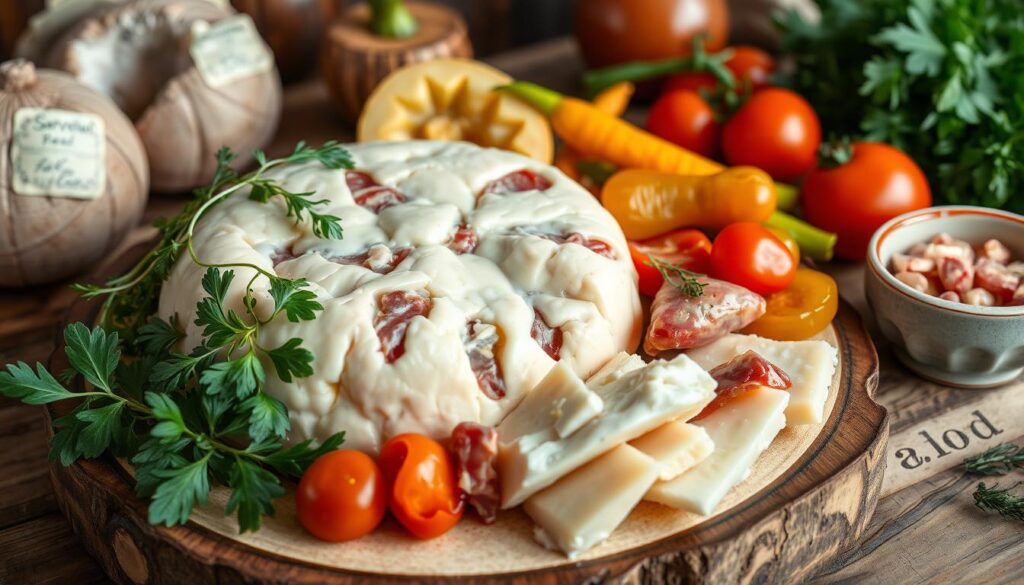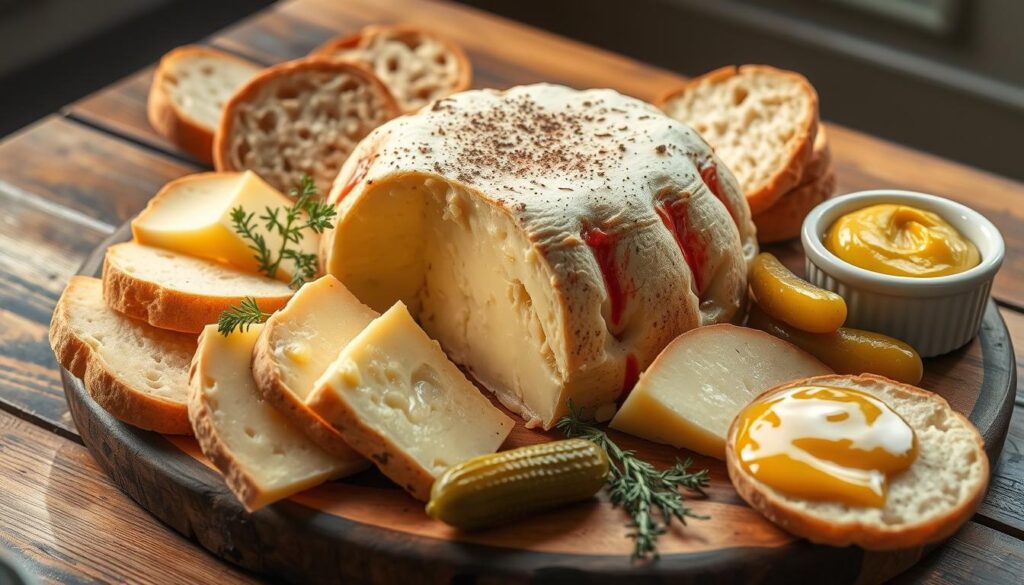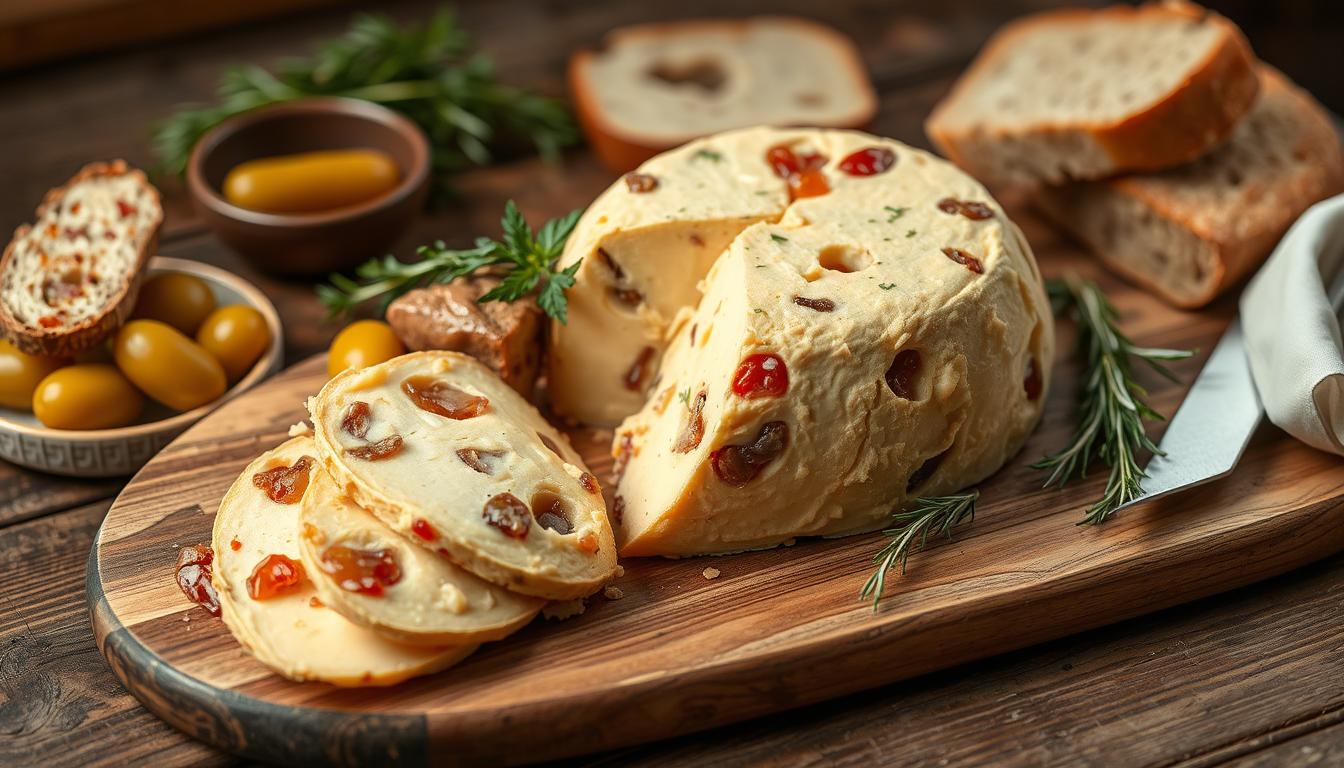When you open the fridge, a savory smell greets you. It’s not just any deli meat—it’s head cheese. This European cold cut has been loved for centuries. Its name might surprise you, but it’s a true culinary gem.
Head cheese is filled with history and complex flavors. It has won the hearts of numerous over Europe. Its rich taste is a testament to its enduring popularity.
Key Takeaways
- Head cheese is a traditional European cold cut made from the tender meat pieces of a pig or calf’s head, set in natural gelatin.
- Each region in Europe has its own unique preparation methods and flavor profiles for head cheese, making it a diverse delicacy.
- Head cheese is not actually cheese, but a savory terrine with a rich history dating back to medieval Europe.
- Head cheese is high in protein and a good source of iron and zinc, though it should be consumed in moderation due to its high-fat content.
- Traditional accompaniments for head cheese include crusty bread or crackers, pickled vegetables, mustard, horseradish, and tart fruit preserves.
Understanding Head Cheese Origins
Head cheese, also known as souse, brawn, or potted meat, has a long history. It dates back to the Middle Ages in Europe. It was made from a calf or pig’s head, sometimes from sheep or cow.
The dish’s many preparations show the culinary diversity of Europe. This makes head cheese a unique and tasty treat.
Historical Background in Medieval Europe
Head cheese was once a food for peasants. It was made and eaten since at least the 15th century. Back then, people used every part of an animal to get more food.
The boiling of animal parts, like the head, made a firm, gelatinous texture. This created the fromage de tête in France and Presskopf in Germany.
Evolution Through Centuries
Over time, head cheese became a favorite dish in Europe. In Italy, it’s called testa in cassetta, coppa di testa, soppressata, or formaggio di testa. In Austria, it’s known as Presswurst, Sulz, or Schwartamaga.
In the Netherlands and Belgium, it’s hoofdkaas or zult. It’s often eaten with Limburgisch sausage.
Cultural Significance
Head cheese shows the resourcefulness and cooking skills of our ancestors. It turns simple ingredients into a tasty dish. Today, it’s still loved in European delis.
This shows the lasting impact of our ancestors’ creativity. Head cheese is a symbol of European food culture.

“Some individuals enjoy head cheese and claim it pairs well with pickles and mustard.”
The Art of Traditional Head Cheese Making
Head cheese, also known as sulze or pressed head, is a delicacy with a rich history. It comes from European culinary traditions. Making this headcheese is a detailed art form passed down through generations.
At the heart of making head cheese is simmering the animal’s head and other parts for hours. This slow cooking process infuses the meat with gelatin from bones and connective tissues. The artisan must carefully remove the cooked meat, making sure no flavor is left behind.
- Simmering the head and other animal parts for hours to extract the natural gelatin
- Meticulously removing the cooked meat, leaving no flavorful morsels behind
- Seasoning the meat with a carefully curated blend of spices and aromatics
- Carefully arranging the seasoned meat in a mold, allowing it to set in its own natural gelatin
- Refrigerating the molded headcheese to allow the flavors to meld and the texture to firm up
The art of making head cheese is about finding the right balance of flavors and textures. Each region has its own twist, with local spices adding depth. This tradition not only keeps European culinary heritage alive but also shows respect for the land and resourcefulness.

“”Head cheese is a genuine confirmation to the resourcefulness and cleverness of our precursors, who denied to let any portion of the creature go to squander. It’s a culinary tradition that connects us to the land and the people who came before us.”
Essential Ingredients and Equipment
Making the perfect head cheese, or “pork terrine,” needs top-notch ingredients and special tools. The main parts are tender meat from a pig or calf’s head, tongue, and cheeks. These add great flavor.
Key Meat Components
- Pork or veal head meat
- Pig or calf tongue
- Pork or veal cheeks
Necessary Kitchen Tools
- Large stockpot for simmering the meat
- Sharp boning knives for deboning and trimming the meat
- Molds or terrines for shaping and setting the final product
Seasonings and Spices
For the perfect head cheese, the right seasonings are key. You’ll need salt, black pepper, garlic, onions, and herbs like thyme and bay leaves. A bit of vinegar adds a nice balance.
| Ingredient | Purpose |
|---|---|
| Salt | Enhances flavor and aids in preservation |
| Black Pepper | Provides a subtle heat and depth of flavor |
| Garlic | Adds aromatic complexity |
| Onions | Imparts sweetness and savory notes |
| Thyme | Lends herbaceous notes |
| Bay Leaves | Contributes a warm, slightly minty flavor |
| Vinegar | Balances the richness and acidity |
The quality and mix of these ingredients and tools are crucial. They help make traditional headcheese taste and feel just right.
Step-by-Step Preparation Process
Making a traditional head cheese recipe is a labor of love. It results in a flavorful and beautiful cold cut. The steps include cleaning and preparing the meat, simmering it with herbs and spices, and setting it in gelatin. Let’s look at how to make this beloved traditional head cheese.
- Begin by cleaning and preparing the meat. This usually involves a pig’s or calf’s head. It needs to be washed and trimmed of any bad parts.
- Then, the head is simmered in a big pot of water. Onions, garlic, and herbs like bay leaves and thyme are added. This long cooking extracts gelatin from bones and tenderizes the meat.
- After the meat is cooked, it’s removed from the broth and cooled a bit. It’s then deboned, chopped, and seasoned with vinegar, salt, and pepper.
- The seasoned meat is packed into a mold or container. The cooking liquid is poured over it. This liquid sets, binding the meat with gelatin.
- Finally, the head cheese is chilled for hours or overnight. This lets it set and develop its unique texture and flavor.
This detailed process can take a day or more. But the result is a remarkable and authentic head cheese recipe. It celebrates the whole animal and Europe’s culinary traditions. With its careful preparation and perfect mix of savory and gelatinous textures, this traditional head cheese is a treat to enjoy.
“Head cheese is a true testament to the nose-to-tail philosophy, honoring the entire animal and the rich culinary heritage of Europe.”
Regional Variations Across Europe
Head cheese, also known as fromage de tête in France and sulze in Germany, is enjoyed in many ways across Europe. Each region has its own twist, using local flavors and ingredients. This makes European cuisine incredibly diverse and rich.
French Fromage de Tête
In France, fromage de tête is a head cheese with a light flavor. It’s often seasoned with herbs like parsley, thyme, and bay leaf. The meat is cooked until it’s tender, then pressed into a mold to blend the flavors.
German Sülze
German sülze has a tangy taste from vinegar. The texture can be firm or crumbly, depending on who makes it. This shows how different people like their head cheese.
Eastern European Interpretations
In Eastern Europe, like Hungary, head cheese is called disznósajt. It’s spiced with paprika, giving it a unique taste. These dishes mix many cultures, showing the area’s rich food history.
| Region | Specialty | Key Characteristics |
|---|---|---|
| France | Fromage de Tête | Delicately flavored with herbs like parsley, thyme, and bay leaf |
| Germany | Sülze | Tangy flavor from the addition of vinegar |
| Eastern Europe | Disznósajt (Hungary) | Spiced with paprika and other regional seasonings |
These different versions of fromage de tête, sulze, and more show Europe’s rich food culture. Each dish has its own special taste, thanks to local ingredients and traditions. This makes head cheese a fascinating part of European cuisine.
Nutritional Benefits and Health Aspects
Head cheese is more than just a tasty cold cut. It’s packed with protein, offering about 24 grams per 100-gram serving. It also has important minerals like iron and zinc, along with B-complex vitamins.
But, head cheese does have some downsides. It’s high in fat, with about 30 grams per 100 grams. It also has a lot of sodium, so eating it in moderation is crucial. The gelatin in head cheese might help with joint and gut health, though.
If you have dietary restrictions or health issues, talk to a doctor before eating head cheese. It’s important to control how much you eat and balance it with other foods. This way, you can enjoy this traditional European dish without worrying about your health.
| Nutrient | Amount per 100g |
|---|---|
| Protein | 24g |
| Iron | 2.1mg |
| Zinc | 3.2mg |
| Fat | 30g |
| Sodium | High |
Head cheese might not be the healthiest option for everyone. But, its nutritional benefits and unique taste make it a great addition to a balanced diet. Remember, moderation and your dietary needs are key when enjoying this traditional European treat.
Serving Suggestions and Pairings
Head cheese is a rich, savory treat with endless serving options. It’s best chilled, perfect for charcuterie boards or sandwiches.
Traditional Accompaniments
Classic pairings include tangy pickled veggies and Dijon mustard. These flavors balance the meaty taste of head cheese. Serve it on crusty bread for a great experience.
Modern Serving Ideas
- Add head cheese to summer salads for texture and taste.
- Top gourmet burgers with head cheese for a special twist.
- Make elegant canapés with head cheese on crostini or crackers.
Wine and Beverage Pairings
Pairing drinks with head cheese offers many choices. White wines like Riesling or Gewürztraminer are refreshing. For red wine fans, Cabernet Sauvignon or Malbec works well. Beer lovers might enjoy robust ales or lagers.
The secret to great head cheese is balancing its bold flavors. Choose from classic or modern pairings to highlight its unique taste. This way, you’ll create a memorable meal.
Storage and Preservation Methods
Keeping head cheese fresh is key. It lasts 3 to 5 days in the fridge. Freezing it for 2-3 months works too, but it might change the texture a bit.
Store head cheese in an airtight container or wrap it well. Don’t let it sit at room temperature for over 2 hours. If it smells bad, looks off, or has mold, throw it away to stay safe.
Serving head cheese within the suggested time frame is best. This way, it stays tasty and keeps its traditional European charm.
Freezing for Longer Shelf Life
Freezing head cheese can make it last 2-3 months. But, it might get a bit firmer and chewier when thawed.
- Wrap the head cheese tightly in plastic wrap or aluminum foil to prevent freezer burn.
- For best results, slice the head cheese before freezing to make it easier to thaw and serve.
- Allow the head cheese to thaw in the refrigerator overnight before serving.
Proper Refrigeration Practices
Keep head cheese in an airtight container or wrap it well in the fridge. This way, it stays moist and flavorful for 3-5 days.
- Always store head cheese on the bottom shelf of the refrigerator, where it’s coldest.
- Avoid leaving head cheese at room temperature for more than 2 hours, as this can lead to bacterial growth.
- Discard any head cheese that develops an off odor, discoloration, or signs of mold.
By using these storage tips, you can enjoy head cheese longer. It stays a delicious and safe European treat.
Conclusion
Head cheese is a big part of European food history. It shows how people used to preserve meat and cook creatively. Even though it has a strange name, it tastes amazing and varies by region.
More people are getting into traditional and artisanal foods. Head cheese is loved by many who want to try new tastes. It’s great on a charcuterie board, in sandwiches, or as a snack.
Head cheese has been around since medieval times. It’s still enjoyed today for its unique taste and how it’s made. It’s a favorite among those who love to try different foods and cooking methods.

